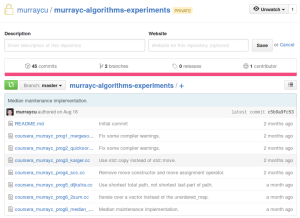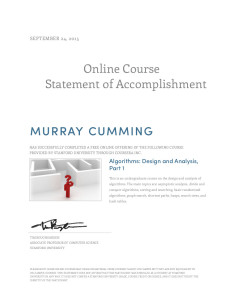 Although I’ve been developing software for years, I noticed recently that I lacked the basic computer science knowledge that other people got at university, though it’s never been an issue outside of job interviews. I knew the basics of Big-O notation and how to use data structures but couldn’t describe exactly how various sort algorithms worked or how to analyze an algorithm’s performance from pseudo-code.
Although I’ve been developing software for years, I noticed recently that I lacked the basic computer science knowledge that other people got at university, though it’s never been an issue outside of job interviews. I knew the basics of Big-O notation and how to use data structures but couldn’t describe exactly how various sort algorithms worked or how to analyze an algorithm’s performance from pseudo-code.
But this is all standard stuff now, so filling in the gaps in my knowledge seemed like a solvable problem. Over the last few weeks, I’ve worked through Coursera’s “Algorithms: Design and Analsis, Part 1” online course, provided by Stanford University. I was surprised to find myself enjoying it. It’s nice to get some insight into commonly used algorithms and data structures, and I guess it does help to inform choices made at a higher level, even if that’s only occasionally useful.
Mostly I enjoyed the programming exercises, writing implementations of Mergesort, Quicksort, Karger’s Minimum Cut Algorithm, Strongly Connected Components, Dijkstra’s Shortest-Path Algorithm, a 2-Sum Algorithm, and a Median Maintenance algorithm. Likewise, each week had a theoretical test, checking knowledge of stuff such as the Master Method, sorting algorithms, graph algorithms, heaps, (balanced) binary trees, hash tables, and bloom filters.
Hopefully I’ll keep it in all my head from now on, but that is always easier when you’ve written actual code that you can look back at. I used C++, but you can use any programming language, and nobody checks your code. Of course, I’m not allowed to publish my homework solutions.
I had already been slowly reading through Introduction to Algorithms, by Cormen, Leiserson, Rivest and Stein, which is hard going. It also has exercises, but I was far more motivated to complete the Coursera exercises, whose aim was always to get the correct specific numerical answer, so you knew when you had the code working properly. After I finished the course, I found it easy to then read the relevant chapters, which offer much more in-depth analysis than the Coursera course.
Although the participants are all still waiting for their certificates (presumably some skeumorphic image file), I’m sure that I’ve passed with 80-something percent. I’d have done better but I started the course after some homework deadlines had already passed. The final test also showed that I need to be more familiar with logarithm equivalences and geometric progressions. I do have Maths and Further-Maths A-Levels, but it’s been a long time.
Unfortunately, part 2 isn’t due to start again until some time in 2016. But I think I can do the course in the meantime, just without earning an official score.
Update: Here is my certificate for part 1:
Update: I did part 2 too.

Nice! I never got to finish a college degree, and yet I’ve had a very successful programming career for the last 20 years or so. And I agree, this stuff is rarely useful outside of programming/technical interviews. But I’ve been thinking about trying to prepare myself for technical interviews for a while now. It sounds like the Coursera program was worth your time?
Absolutely. I feel I’ve benefited greatly from it. It has stretched my brain in useful ways. The Part 1 course is starting today, so I think you should go for it.
https://www.coursera.org/course/algo
I started a few weeks after the start date, but it’s worth starting earlier to give yourself enough time to be comfortably thorough, maybe reading the recommended book chapters too.